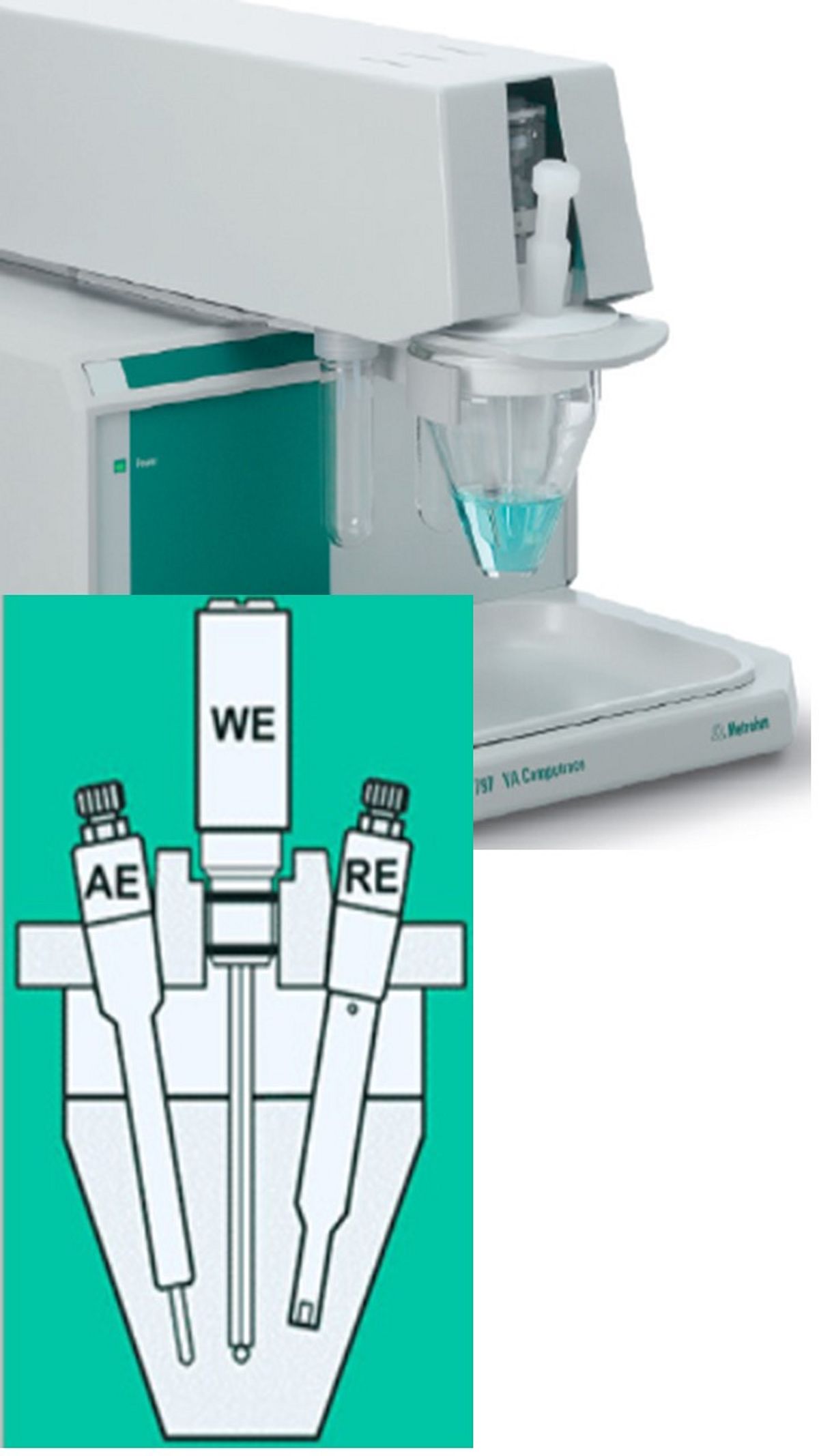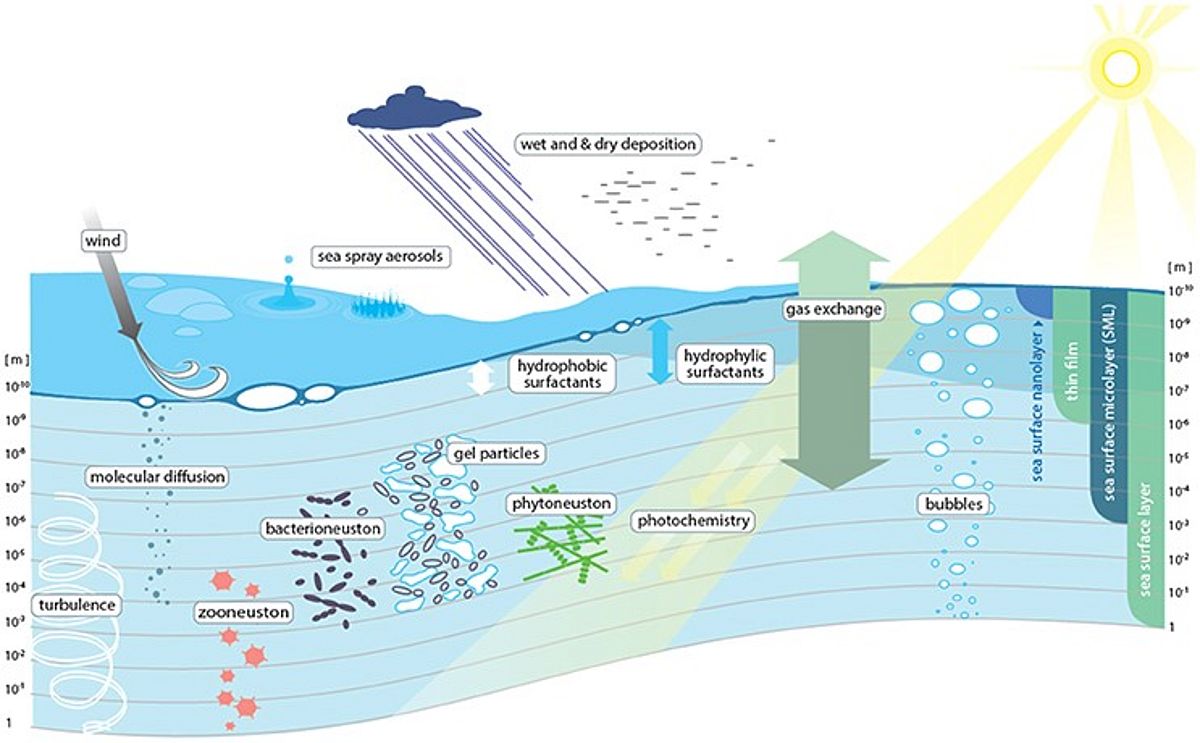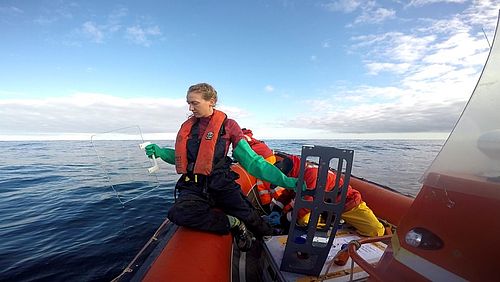The sea surface microlayer as the surrogate between the ocean and atmosphere: its biogenic control on major climate-related processes
The sea surface microlayer (SML) is a thin organic biofilm, located at the very surface of the ocean, linking the hydrosphere to the atmosphere (Figure 1). Apart from its distinct and complex biochemical composition it serves as habitat to a variety of microbes. The SML is central to a range of global biogeochemical and climate-related processes. The SML may modify air-sea gas exchange rates in two principal ways: biogenic substances can have a direct or indirect effect on the physicochemical properties of seawater by forming a static barrier or reducing the available surface area for gas exchange due to increased viscosity. Further, microbial cells inhabiting the SML may alter exchange rates by consumption, respiration or production of several gases. Fragments, molecules and organisms enriched in the SML are also a source of primary aerosols that are emitted to the atmosphere by generated sea spray. Marine aerosols are especially important in the southern hemisphere due to reduced terrestrial dust input. Particles and molecules serve as condensation or ice crystallization nuclei (CN and IN) for clouds. Aerosols and clouds exhibit control on the hydrological cycle and the Earth radiation budget.
Our studies investigate the relationship between the formation of a biogenic SML and oceanic and atmospheric controls e.g. the hydrological regime. We focus on organic compounds that accumulate in the SML and are primarily of planktonic origin such as polysaccharides, polypeptides and gel particles, explicitly transparent exopolymer particles (TEP) and coomassie stainable particles (CSP). Nano- and pico-planktonic organisms are assessed by flow cytometry. To assess surface activity of the sample as a measure for amphiphilic and hydrophobic substance enrichment, we apply voltammetry. Our studies aim at a better understanding of how accumulation and composition of organic matter in the SML influences gas exchange rates and aerosol emission.
- Sampling of the Sea Surface Microlayer
The SML can be collected by several techniques, one of which is the deployment of a glass plate after Harvey and Burzell (1972). This technique makes use of the hydrophilic surface of the glass plate. For sampling, the glass plate is lowered through the water surface and slowly and perpendicularly withdrawn (Figure 2). Due to surface tension, it collects the uppermost layer of the ocean. Subsequently, the sample is whipped of the plate and pooled in a bottle. The SML collected by this technique measures approximately 100µm in depth. Sampling with the glass plate requires rather calm weather conditions since the deployment of a working boat is wind and wave dependent, which is also representative for the limits set to SML research. Weather dependencies lead to a general under sampling of the SML at high sea state. Other sampling methods applied by our group include the Garrett-Screen technique (Garrett 1965), where the SML is collected between a narrow grid of metal mashes.
- Surface activity measurements by AC phase sensitive voltammetry

Substances which influence surface properties of seawater are generically referred to as ‘surfactants’ while when focusing on the effect it is often referred to ‘surface activity’. Only a small fraction of marine biogenic substances can be molecularly described and identified. To quantify the amount of surface active substances present in the SML, we deploy the electrochemical method after Ćosović and Vojvodić (1982). Phase sensitive voltammetric measurement of surface activity is derived from competitive adsorption effects of substances on a polar to non-polar interface. The basic components of the polarograph (757 VA Computrace, Metrohm, Switzerland) are the working electrode (WE), consisting of a capillary and a mercury reservoir, and an Ag/AgCl reference electrode (RE), which are supported by an auxiliary electrode (AE) (Figure 3). All electrodes are lowered into the sample, which also serves as natural electrolyte based on its salt content. Generated capacity-current potential curves reflect the amount of surfactants present in a solution. Samples are calibrated against a known surfactant solution (Triton-X 100) and electrolyte blanks.
Projects:
- Surface Ocean Processes in the Anthropocene (SOPRAN II + III), PI: Prof. Anja Engel, Dr. Luisa Galgani, Dr. Birthe Zäncker
- Biological cycling of climate-active trace gases in the surface ocean (Kiel Excellence Cluster “The Future Ocean”; CP1405), PI: Dr. Sonja Endres
- The sea surface microlayer (Kiel Excellence Cluster “The Future Ocean”; CP1146); PhD candidate Alexander Dreshchinskii, PI: Prof. Anja Engel
- Surface Ocean Lower Atmosphere Study (SOLAS)
- SCOR Sea Surface Microlayer Working Group (WG141)




